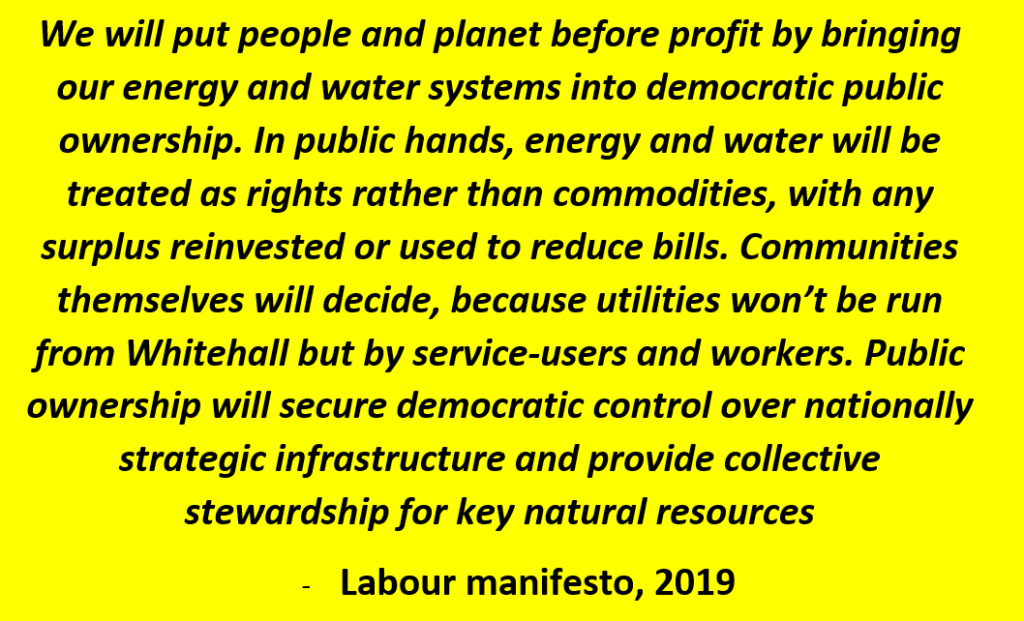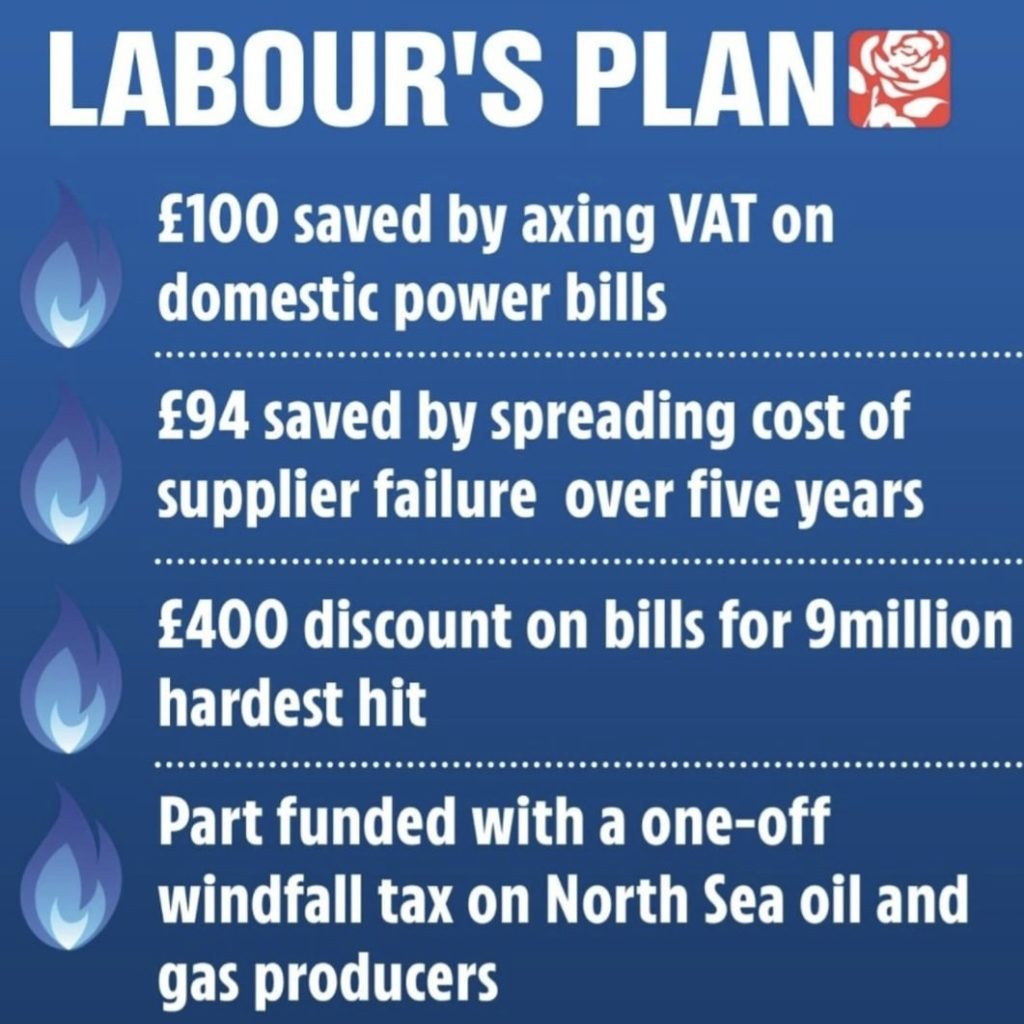By John Pickard, Brentwood and Ongar Labour member
When the Tory government lifts the ‘cap’ on energy prices in April, as a result of the massive spike in the price of natural gas and Liquefied Natural Gas on the world and European markets, it will mean a huge leap in energy costs for households.
Working class families are already facing a whirlwind of rising costs, in relation to rents, fares, food prices, and general inflation. More money will be taken directly out of wage packets through increases in National Insurance payments and higher income tax by the freeze on thresholds after April.
The impact of these things together mean that “households in Britain will be hit by a cost of living jump…larger than anything seen since the 2008-09 financial crisis — and possibly worse than anything seen in a generation, according to experts in household finances”. (Financial Times, January 6)
The biggest single factor in the squeeze on living standards will be energy costs and we should be under no illusions about the scale of the increases in the pipeline. The Financial Times reported that calculations from Investec (an investment company), “suggest the price cap will rise by 56 per cent in April, pushing the typical energy bill from £1,277 to just shy of £2,000 a year”.
It is further being suggested that the cap will be increased again later in the year. “Using the latest market pricing”, the Financial Times reports, “EnAppSy [energy market analysts] estimates that later this year the cap could hit between £2,300 and £2,400, unless the government and regulator intervene to relieve pressure on consumers.” Rises of this order will mean that energy prices will have more than doubled in a year.
Millions more will be in real poverty
For ordinary families, and based on average household consumption, the expected energy price increase in April translates into a rise of around £60 a month. If the projected rise in October also takes place, it is another £35 a month. This might be nothing to the millionaires and billionaires who infest the Tory cabinet, but they are devastating blows to ordinary families and the less well-off they are the bigger, proportionally, is the squeeze.
According to the government’s own figures (ONS), ten months ago there were nearly 3 million children living in families in ‘relative’ low income and over 2.4m in ‘absolute’ low income. The official data does not use the word ‘poverty’ but that is what it means. In the sixth richest country in the world, five and a half million children live in poverty, a third of the total.

What the energy price rises will mean, on top of other cuts, is that millions of parents will be having to make a choice between eating and heating. What applies to families with children will apply equally to many pensioners. So-called ‘fuel poverty’ is already rife and is set to grow massively.
The background to the energy price increases is the international market price for natural gas. But the question that has to be asked by Labour Party members is this – is a price rise inevitable, or is it a feature of the capitalist market that could and should be avoidable?
Once upon a time the bulk of the energy industry in the UK was owned by the public. British Gas was a state-owned utility with distribution and retail arms in every region. The same was true of electricity production. The Central Electricity Generating Board was also state-owned and it supplied electricity through the National Grid (state-owned) to every region.
Big six energy companies command three quarters of the market
All of these utilities were privatised under the Thatcher government: British Gas in 1986 and the regional electricity companies beginning in 1990. Since then, energy has come to be dominated by six big companies: Centrica (who own what is left of British Gas), EDF (owned outright by the French government), E.on, npower, Scottish Power and SSE (now owned by OVO energy). There are a many other smaller players, although over twenty of them went bust when they sold and were tied into fixed price agreements as wholesale gas prices rose. The ‘big six’ control over three quarters of the UK energy market.
Since privatisation, the energy companies have not been slow to bump up prices. According to a 2019 BBC article, since 1996 in real terms, electricity bills have risen by a third and gas bills by over a half.
A government body, the ‘energy regulator’ or Ofgem, has done little to prevent the exploitation of consumers by the big companies. Ofgem imposed a ‘cap’ on prices, in 2019, but this is reviewed twice a year and is being raised to match market prices. It is this cap which is being lifted in April of this year. So while Ofgem is supposed to ‘regulate’ the market, it is not exactly the champion the consumer.
In the recent period, where smaller companies have gone to the wall, it is Ofgem that directs one of the remaining companies – often one of the big six – to take over the distribution to customers left without a provider. The consumer has no choice who Ofgem place them with, if their provider goes bust.

Where customers have fixed-term agreements, the new provider hasn’t had to bear the cost; instead it is passed on to the tax-payer. So currently the government is paying nearly £2bn in subsidies to the big energy companies who have taken over customers with these deals from bankrupt smaller companies.
There is a question mark over how many of these small companies were allowed into the market in the first place. The Financial Times (December 8, 2021): reported that the consumer group Citizens Advice had criticised Ofgem for a “catalogue of errors” in its oversight of the supply market over the past decade that allowed “a culture where companies were free to flout the rules”.
Massive profits made since privatisaiton
Citizens Advice claimed “it first formally raised concerns with Ofgem in 2013 about poorly run suppliers entering the market but rules were not tightened until six years later. It also highlighted fears about the second biggest supplier to have collapsed this year, Avro Energy, on 10 occasions from 2018 but the company was allowed to continue expanding. Avro alone is expected to cost consumers £679m”.
Not surprisingly, the energy companies have made massive profits since privatisation and when the energy cap is lifted, they will make more windfall profits. In 2019, the then Shadow energy secretary, Rebecca Long-Bailey, pointed out that “companies have been able to post huge profit margins.” Ofgem reported at that time that profit margins were 4%, an increase from 1% in the previous ten years. British Gas made 8% profit.
The big companies have ‘business models’ like so many other big utilities that are based on maximising profits at the expense of high prices, minimal customer support and minimal investment. Outsourcing processes to cheaper companies is the norm. A gas leak near you will not be repaired by a gas company, but more likely by a contracted or sub-contracted company hired to botch the job.
According to the available data for the last ten years, 2011 to 2020, the Big Six have paid out almost £23 billion in dividends: six times their tax bill for the period. Just as it has been for the privatised water utilities, the energy firms’ have loaded up with external loans (rather than use profits) to subsidise any investment, so the big six are increasingly weighed down by debt, paying £10bn in interest in these ten years. Ultimately, it is the consumer who pays for both dividend and interest, creating a vast river of cash flowing out of utilities that were once owned by the public.
Lack of investment by privatised companies
The storms late last year that led to many thousands of homes being without electricity for weeks exposed in part the lack of investment by electricity companies in the resilience of their networks. Northern Power, one of the companies particularly criticised, is owned by US billionaire Warren Buffet.
According to the Financial Times, (December 8, 2021) “Industry executives admitted that there was a 7.7 per cent underspend on the £795m approved for resilience in the first five years of an eight-year regulatory settlement with Ofgem”.
It is patently clear, in other words, that privatisation has not been to the benefit of energy consumers. On the contrary, it has been a device to transfer billions of pounds out of the pockets of consumer and into the bank accounts of private investors. It is not a surprise, therefore, that there is a national consensus in favour of the public ownership of energy utilities.
Majority public support for nationalisation of energy utilities
It is only because of privatisation and the drive for quick profits that energy supply is so vulnerable to the volatility of international market conditions. Privatisation has meant that gas storage facilities in the UK have been run down to the equivalent of only 2% of annual demand – a tenth of the average figure in Europe. Storage is simply not profitable, but the lack of it makes the UK more vulnerable to sudden increases in the wholesale market price.

But the dearth of investment and the drive for profits have also meant that the privatised energy industry has not invested in reliable renewables like wind, solar and tidal energy on anything like the scale they should have done. A publicly-owned energy industry, under a socialist government, would have been able to invest massively, for example in solar energy capacity, utilising the roof space on public buildings like schools and hospitals. Even before installing SV panels in homes, a national plan of solar energy installation in large public buildings would satisfy a huge proportion of regular demand.
According to a YouGov poll last month, 59% of people either ‘strongly support’ or ‘tend to support’ the public ownership of energy companies. This is against only 13% who strongly or tend to oppose. Among Labour voters, over two thirds support public ownership. Among under 25 year olds, the figure is 69%. Among Labour voters, there is 68% in favour of public ownership, with only 9% against. The last Labour manifesto, in 2019, reflected, therefore, what is a widespread public view.
Labour manifesto had commitment to public ownership
“Tory privatisation of our utilities”, it said, “has been a disaster for both our planet and our wallets.” The manifesto made a clear commitment to public ownership: We will put people and planet before profit by bringing our energy and water systems into democratic public ownership. In public hands, energy and water will be treated as rights rather than commodities, with any surplus reinvested or used to reduce bills. Communities themselves will decide, because utilities won’t be run from Whitehall but by service-users and workers. Public ownership will secure democratic control over nationally strategic infrastructure and provide collective stewardship for key natural resources”.
Likewise, at the Labour conference, most recently in 2021, the overwhelming view of the Labour membership was in favour of public ownership. In a composite resolution on a Green New Deal, conference explicitly expressed its support for “Public ownership of energy including energy companies, creating an integrated, democratic system” (See full composite resolution here). In fact, in the recent Shadow Cabinet reshuffle, former leader Ed Miliband was demoted specifically for having ‘accidentally’ defended Labour’s previous position in favour of public ownership of energy – which is clearly not the message the new leadership of Starmer wanted to present.
Starmer and Reeves energy policy is based on status quo
What is the policy of the new Labour leadership? In fact, faced with the biggest single increases in energy prices for a generation and a massive blow to living standards, Labour’s front bench are struggling to find a policy that matches up to the needs of the moment. An e-mail to Labour members by Rachel Reeves implied only that Labour would mitigate the worst of the increases. While families are facing a hike in monthly payments of around £60 a month (£700 a year), the best that the Shadow Chancellor offered was is a policy to mitigate £200 of that increase.

A Labour ‘poster’ (left) that has appeared on Instagram (although it was nowhere to be found on Labour’s website) offered a selection of policies to deal with the expected huge increase in energy prices:
As a plan to deal with the expected rises, this is Tory-lite at best. No-one would argue with any measure, such as the abolition of VAT on energy, that mitigates against steep rises. But the problem is that ‘half’ an answer is really no answer at all. A discount for the nine million ‘hardest-hit’ households, still leaves around 14 million others with massive increases in bills. Saving around £200 a year of an expected rise of £700 still leaves the overwhelming majority of workers much worse off. And that is before the extra rises expected in October this year.
It is clear that the policy of Keir Starmer and Shadow Chancellor, Rachel Reeves, is based on the status quo – on the continuation of privately-owned utilities and the free market. It is a policy out of whack with what Labour members and Labour voters would want and it is a policy that will fail.
Rather than tinkering around the edges of the problem, the Labour leadership ought to be campaigning on what Labour Party members want and what Labour voters want: public ownership and planning. There are many models of public ownership – in Germany, for example, it is common for municipalities to own the electrical distribution systems – but whatever the mix of models that are appropriate, UK energy production and distribution systems need to be based on public ownership and democratic planning, with the explicit aim of providing a service to consumers and not windfall gains to profiteers.



